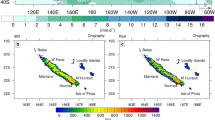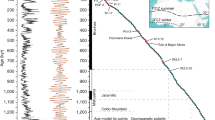Abstract
Recent global-scale analyses of the CMIP3 model projections for the twenty-first century indicate a strong, coherent decreased precipitation response over Central America and the Intra-America Seas region. We explore this regional response and examine the models’ skill in representing present-day climate over this region. For much of Central America, the annual cycle of precipitation is characterized by a rainy season that extends from May to October with a period of reduced precipitation in July and August called the mid-summer drought. A comparison of the climate of the twentieth century simulations (20c3m) with observations over the period 1961–1990 shows that nearly all models underestimate precipitation over Central America, due in part to an underestimation of sea surface temperatures over the tropical North Atlantic and an excessively smooth representation of regional topographical features. However, many of the models capture the mid-summer drought. Differences between the A1B scenario (2061–2090) and 20c3m (1961–1990) simulations show decreased precipitation in the future climate scenario, mostly in June and July, just before and during the onset of the mid-summer drought. We thus hypothesize that the simulated twenty-first century drying over Central America represents an early onset and intensification of the mid-summer drought. An analysis of circulation changes indicates that the westward expansion and intensification of the North Atlantic subtropical high associated with the mid-summer drought occurs earlier in the A1B simulations, along with stronger low-level easterlies. The eastern Pacific inter-tropical convergence zone is also located further southward in the scenario simulations. There are some indications that these changes could be forced by ENSO-like warming of the tropical eastern Pacific and increased land–ocean heating contrasts over the North American continent.


















Similar content being viewed by others
References
Adams DK, Comrie AC (1997) The North American monsoon. Bull Am Meteorl Soc 78:2197–2213
Aguilar E, Peterson TC, Obando PR, Frutos R, Retana JA, Solera M, Soley J, García IG, Araujo RM, Santos AR, Valle VE, Brunet M, Aguilar L, Álvarez L, Bautista M, Castañón C, Herrera L, Ruano E, Sinay JJ, Sánchez E, Oviedo GIH, Obed F, Salgado JE, Vázquez JL, Baca M, Gutiérrez M, Centella C, Espinosa J, Martínez D, Olmedo B, Espinoza CEO, Núñez R, Haylock M, Benavides H, Mayorga R (2005) Changes in precipitation and temperature extremes in Central America and northern South America, 1961–2003. J Geophys Res Atmos 110:23107. doi:10.1029/2005JD006119
Amador JA (1998) A climatic feature of the tropical Americas: the trade wind easterly jet. Top Meteor Oceanogr 5:1–13
Chou C, Neelin JD (2004) Mechanisms of global warming impacts on regional tropical precipitation. J Clim 17:2688–2701
Curtis S (2002) Interannual variability of the bimodal distribution of summertime rainfall over Central America and tropical storm activity in the far-eastern Pacific. Clim Res 22:141–146
Curtis S (2004) Diurnal cycle of rainfall and surface winds and the mid-summer drought of Mexico/Central America. Clim Res 27:1–8
Dai A (2006) Precipitation characteristics in eighteen coupled climate models. J Clim 19:4605–4630
Dai A, Trenberth KE (2004) The diurnal cycle and its depiction in the Community Climate System Model. J Clim 17:930–951
Enfield DB (1996) Relationships of inter-American rainfall to tropical Atlantic and Pacific SST variability. Geophys Res Lett 23:3305–3308., doi:10.1029/96GL03231
Enfield DB, Alfaro EJ (1999) The dependence of Caribbean rainfall on the interaction of the tropical Atlantic and Pacific oceans. J Clim 12:2093–2103
Enfield DB, Mayer DA (1997) Tropical Atlantic sea surface temperature variability and its relation to El Niño-Southern Oscillation. J Geophys Res 102:929–946. doi:10.1029/96JC03296
Gamble D, Parnell D, Curtis S (2007) Spatial variability of the Caribbean mid-summer drought and relation to the North Atlantic high circulation. Int J Clim. doi:10.1002/joc.1600
Giannini A, Kushnir Y, Cane MA (2000) Interannual variability of Caribbean rainfall, ENSO, and the Atlantic Ocean. J Clim 13:297–311
Gill AE (1980) Some simple solutions for heat-induced tropical circulation. Quart J Roy Meteorol Soc 106:447–462
Giorgi F (2006) Climate change hot-spots. Geophys Res Lett 33:8707. doi:10.1029/2006GL025734
Giorgi F, Bi X (2005) Updated regional precipitation and temperature changes for the 21st century from ensembles of recent AOGCM simulations. Geophys Res Lett 32:21715. doi:10.1029/2005GL024288
Hastenrath S (1966) On general circulation and energy budget in the area of the Central American seas. J Atmos Sci 23:694–711
Hastenrath S (1967) Rainfall distribution and regime in Central America. Arch Meteor Geophys Bioklimatol Ser B 15:201–241
Hastenrath S (1976) Variations in low-latitude circulation and extreme climatic events in the tropical Americas. J Atmos Sci 33:202–215
Hastenrath S (1978) On modes of tropical circulation and climate anomalies. J Atmos Sci 35:2222–2231
Hastenrath S (2002) The intertropical convergence zone of the eastern Pacific revisited. Int J Clim 22:347–356
Inoue M, Handoh IC, Bigg GR (2002) Bimodal distribution of tropical cyclogenesis in the Caribbean: characteristics and environmental factors. J Clim 15:2897–2905
Intergovernmental Panel on Climate Change (2000) Special report on emissions scenarios. A special report of Working Group III of the Intergovernmental Panel on Climate Change (Nakicenovic N and lead authors). Cambridge University Press, Cambridge, pp 599
Kalnay E, Kanamitsu M, Kistler R, Collins W, Deaven D, Gandin L, Iredell M, Saha S, White G, Woollen J, Zhu Y, Leetmaa A, Reynolds B, Chelliah M, Ebisuzaki W, Higgins W, Janowiak J, Mo KC, Ropelewski C, Wang J, Jenne R, Joseph D (1996) The NCEP/NCAR 40-year reanalysis project. Bull Am Meteorl Soc 77:437–472
Knaff JA (1997) Implications of summertime sea level pressure anomalies in the tropical Atlantic region. J Clim 10:789–804
Li JL, Zhang XH, Yu YQ, Dai FS (2004) Primary reasoning behind the double ITCZ phenomenon in a coupled ocean–atmosphere general circulation model. Adv Atmos Sci 21:857–867
Madden J, Julian PR (1994) Observations of the 40-50 day tropical oscillation: a review. Mon Weather Rev 122:814–837
Magaña V, Caetano E (2005) Temporal evolution of summer convective activity over the Americas warm pools. Geophys Res Lett 32:2803. doi:10.1029/2004GL021033
Magaña V, Amador JA, Medina S (1999) The midsummer drought over Mexico and Central America. J Clim 12:1577–1588
Maloney ED, Hartmann DL (2000) Modulation of eastern North Pacific hurricanes by the Madden-Julian Oscillation. J Clim 13:1451–1460
Mapes BE, Liu P, Buenning N (2005a) Indian monsoon onset and the Americas midsummer drought: out-of-equilibrium responses to smooth seasonal forcing. J Clim 18:1109–1115
Mapes BE, Buenning N, Kang IS, Kiladis GN, Schultz DM, Weickmann KM (2005b) Strides, steps and stumbles in the march of the seasons (unpublished manuscript) http://www.rsmas.miami.edu/users/bmapes/pagestuff/BAMS.AnnualCycle6.pdf
Meehl GA, Stocker TF, Collins W, Friedlingstein P, Gaye A, Gregor J, Kitoh A, Knutti R, Murphy J, Noda A, Raper S, Watterson I, Weaver A, Zhao ZC (2007) Global climate projections. In: Solomon S, Qin D, Manning M, Chen Z, Marquis M, Averyt K, Tignor M, Miller H (eds) Climate change 2007: the physical science basis. Contribution of Working Group I to the fourth Assessment Report of the Intergovernmental Panel on Climate Change, Chap. 10. Cambridge University Press, New York, pp 747–846
Mitchell TD, Carter TR, Jones PD, Hulme M, New M (2004) A comprehensive set of high-resolution grids of monthly climate for Europe and the globe: the observed record (1901–2000) and 16 scenarios (2001–2100), Working Paper 55, Tyndall Centre
Neelin JD, Chou C, Su H (2003) Tropical drought regions in global warming and El Niño teleconnections. Geophys Res Lett 30(24):2275
Neelin JD, Münnich M, Su H, Meyerson JE, Holloway CE (2006) Tropical drying trends in global warming models and observations. PNAS 103:6110–6115. doi:10.1073/pnas.0601798103
Peña M, Douglas MW (2002) Characteristics of wet and dry spells over the Pacific side of Central America during the rainy season. J Clim 130:3054–3073
Portig W (1965) Central American rainfall. Geogr Rev 55:68–90
Rayner NA, Horton EB, Parker DE, Folland CK, Hackett RB (1996) Version 2.2 of the global sea-ice and sea surface temperature data set, 1903–1994, Climate Research Technical Note 74, Hadley Centre
Riehl H (1979) Climate and weather in the tropics. Academic Press, London
Rodwell MJ, Hoskins BJ (2001) Subtropical anticyclones and summer monsoons. J Clim 14:3192–3211
Romero-Centeno R, Zavala-Hidalgo J, Gallegos A, O’Brien JJ (2003) Isthmus of Tehuantepec wind climatology and ENSO signal. J Clim 16:2628–2639
Ropelewski CF, Halpert MS (1987) Global and regional scale precipitation patterns associated with the El Niño/Southern Oscillation. Mon Wea Rev 115:1606–1626
Small RJO, de Szoeke SP, Xie SP (2007) The Central American mid-summer drought: regional aspects and large-scale forcing. J Clim (in press)
Taylor MA, Enfield DB, Chen AA (2002) Influence of the tropical Atlantic versus the tropical Pacific on Caribbean rainfall. J Geophys Res Oceans 107. doi:10.1029/2001JC001097
Trenberth KE, Jones P, Ambenje P, Bojariu R, Easterling D, Tank AK, Parker D, Rahimzadeh F, Renwick J, Rusticucci M, Soden B, Zhai P (2007) Observations: surface and atmospheric climate change. In: Solomon S, Qin D, Manning M, Chen Z, Marquis M, Averyt K, Tignor M, Miller H (eds) Climate change 2007: the physical science basis. Contribution of Working Group I to the Fourth Assessment Report of the Intergovernmental Panel on Climate Change, Chap 3. Cambridge University Press, New York, pp 235–336
Vecchi GA, Soden BJ (2007) Increased tropical Atlantic wind shear in model projections of global warming. Geophys Res Lett 34:L08702
Wang C (2007) Variability of the Caribbean low-level jet and its relations to climate. Clim Dyn 29:411–422
Wang C, Lee SK (2007) Atlantic warm pool, Caribbean low-level jet, and their potential impact on Atlantic hurricanes. Geophys Res Lett 34. doi:10.1029/2006GL028579
Wang C, Lee SK, Enfield DB (2007) Impact of the Atlantic warm pool on the summer climate of the Western Hemisphere. J Clim 20:5021–5040
Waylen PR, Caviedes CN, Quesada ME (1996) Interannual variability of monthly precipitation in Costa Rica. J Clim 9:2606–2613
Wilmott CJ, Matsuura K (2001) Terrestrial air temperature and precipitation: monthly and annual time series (1950–1999). http://www.climate.geog.udel.edu/~climate/html_pages/README.ghcn_ts2.html
Xie P, Arkin PA (1996) Analysis of global monthly precipitation using gauge observation, satellite estimates and numerical model predictions. J Clim 9:840–858
Xie SP, Miyama T, Wang Y, Xu H, de Szoeke S, Small R, Richards K, Mochizuki T, Awaji T (2007) A regional ocean–atmosphere model for Eastern Pacific climate: toward reducing tropical biases. J Clim 20:1504–1522
Acknowledgments
We acknowledge the modeling groups for providing their data for analysis, the Program for Climate Model Diagnosis and Intercomparison (PCMDI) for collecting and archiving the model output, and the JSC/CLIVAR Working Group on Coupled Modelling (WGCM) for organizing the model data analysis activity. The multi-model data archive is supported by the Office of Science, U.S. Department of Energy. We thank Dr. Xunqiang Bi for downloading and processing some of the data used in this analysis. We are grateful to Dr. David Enfield, Dr. Scott Curtis, Dr. Alessandra Giannini, Dr. Fred Kucharski, and three anonymous reviewers for their extremely helpful comments and enlightening discussion of this work.
Author information
Authors and Affiliations
Corresponding author
Rights and permissions
About this article
Cite this article
Rauscher, S.A., Giorgi, F., Diffenbaugh, N.S. et al. Extension and Intensification of the Meso-American mid-summer drought in the twenty-first century. Clim Dyn 31, 551–571 (2008). https://doi.org/10.1007/s00382-007-0359-1
Received:
Accepted:
Published:
Issue Date:
DOI: https://doi.org/10.1007/s00382-007-0359-1




